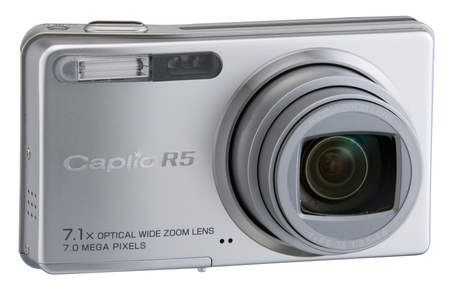My first impressions of the R5 are of a svelte, compact digital compact, its all-metal body is both sturdy and nice to hold thanks to a subtle curve (accentuated by the body styling) on the right side of the body.
Our quick take
I wanted to heartily recommend this camera to you but on balance, I can’t. The Ricoh Caplio R5 straddles the gap between full control and automation nicely, its feature set and build quality almost perfect for the market it’s aimed at – and as the price has just dropped by almost £30, it looks a bargain at £249. But a camera that crashes and its issues around noise mean it cannot glean top marks in this test.

Ricoh Caplio R5 digital camera - 3.5 / 5
| FOR | AGAINST |
|---|---|
|
|
Out of the box the machine seems to fit its billing as a desirable and comprehensively specified digital camera. What you get once the long life lithium-ion battery is charged up and installed in the camera and it is turned on is the remarkable sight of the 28-200mm, F/3.3 to F/4.8 optical zoom lens jumping from the camera’s petite body. Where does all that lens come from?
A 7.24-megapixel sensor captures the light collected by the Ricoh optics and adds another trick, CCD anti shake. This system (similar to Konica Minolta’s – and now Sony on its Alpha 100 D-SLR) shifts the sensor to compensate for user movement reducing the effects of camera shake in low lighting or at the longer focal lengths.
Sensitivity runs up to a respectable ISO 1600 with a range that starts at ISO 64 through 100, 200, 400, and 800. However, as you’d expect, noise at higher ISOs becomes an issue, so enter Ricoh’s new image processing engine, the aptly named “Smooth Image Engine II”.
The engine is designed to help offset the worst aspects of image noise but over-processing can often remove detail. On the R5, over-processing and removal of detail is not the issue, too much noise is. Despite the claims made by Ricoh for the new processing engine, once set over ISO 200 noise is intrusive and gets worse as you climb to ISO 1600. Even at the top quality ISO 64 setting, it’s still apparent in shadow areas of images. So, it becomes a real disappointment; perhaps a firmware upgrade may resolve this in time and I hope so, as the large print sizes this camera is otherwise capable of (easily over A3 plus) cannot be achieved without that noise being obvious.
On a brighter note, other key kit includes exposure bracketing (+/-05EV either side of the “as metered” exposure) and a superb 1cm macro mode; you can really fill the frame with smaller subjects, and you get 14cm macro at full zoom into the bargain. The camera is also very responsive, with a 0.09-second shutter response time (with CCD anti shake off) and a top frame rate of up to 2.8fps (without flash), so in terms of speediness the R5 claws back some points.
Controls are well placed, all barring the tiny zoom lever, which sits on the camera’s back and is frankly fiddly to use. However, the other controls ranged alongside the excellent 2.5-inch colour screen provide the usual array of playback, display toggle that can also bring up an active histogram (luminance only) that helps quickly check the exposures are okay.
My favourite control is the “ADJ”(ust) button. This quickly toggles between preset options such as ISO, white balance, exposure compensation and image size. This makes the use of menus less irksome as you can preset and assign the options you want to control to the ADJ button in advance.
A four-way jog button and central OK/Menu button allow image and menu scrolling plus flash mode, macro mode, quick review and Mode selection when in the “SCN” (or scene) mode, via as witch on the right side of the body.
With “SCN” selected, the Mode button allows scrolling through the R5’s ten pre-set scene programs that include portrait, landscape, and a neat Skew Correction mode for helping to straighten converging verticals for example. Plus you get two custom presets for fast access to your favourite mode.
So apart from the lens zoom lever, handling and control is good, but on the down side again, what was less good was the occasional camera crash! Three times on start up the camera just locked up, unwavering in its stubbornness to do anything other than sit there. Removal of the battery and restarting by pressing the on/off button on the top plate (alongside the shutter release) and all was well again. Thankfully, it did not cause the loss of any images either.
In terms of performance, the 256-segment metering system worked well, with up to +/-2EV exposure compensation available for more tricky lighting. The focus system worked reliably enough but I found the Landscape mode’s infinity focus setting slightly soft; sharpness can be increased in camera, however I found a slight tweak of Unsharp masking in, say, Photoshop the better bet. Finally, the images are stored on the respectable 26MB of internal memory or external SD/MMC cards that slot in alongside the battery, so there’s plenty of scope for storing the shots you take.
In terms of overall image quality then, the package is hampered by the aforementioned image noise, which is present in all shots from ISO 64 (in shadow areas) upwards, becoming marked above ISO 200. The new noise reduction system in the R5 just does not do enough – but at least detail is largely retained. Astute use of noise reduction software via post processing using software such as Neat Image for example will help out here, but this remains a disappointment.
To recap
Ricoh’s Caplio R5 builds on its predecessor the R4; a neat new digital compact packed with great features
